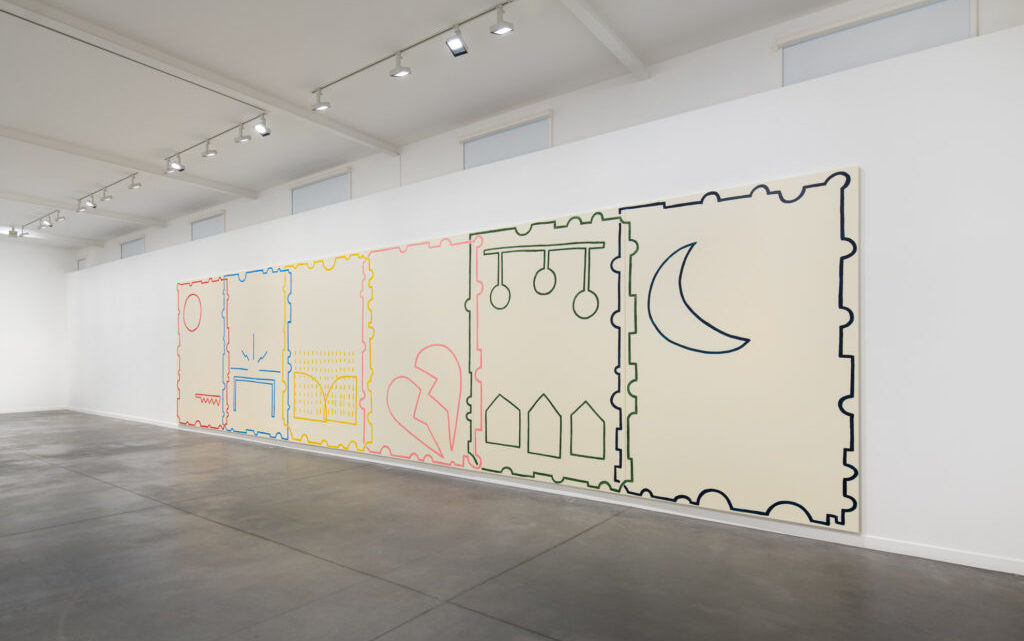« Everyone’s life is a love story ». in Stephen Felton’s eyes. Based in Brooklyn, this American painter and lover of love stories travelled all the way to the Frac Champagne-Ardenne to regale us with his pictorial story.
In a language situated between pictograms and riddles, his version of the clichéd ‘and they all lived happily ever after’ is on exhibition until 25 October 2020. An exhibition designed as a show, by an artist who likes to try his hand at everything.
The scene was set for a chance encounter. It was during a meeting at the Pompidou Centre in Metz that Marie Griffay, Director of the Frac Champagne-Ardenne, first made Stephen Felton’s acquaintance. As one of the artists featured in the ‘Peindre la Nuit’ exhibition, he was at the gallery for its opening – providing the event’s organiser, Jean-Marie Gallais, with the perfect opportunity to introduce them. While Marie Griffay was initially drawn to his work by his unique and very spontaneous approach – a freehand between relaxation and concentration – and his extremely pure lines, it was the Frac itself that ultimately brought them together. For several years Stephen Felton has toyed with the idea of an exhibition, a remake of a love story that would be the plot of all love stories. A show over two acts which fits perfectly with the architecture of the art space. The start of a blossoming romance.




“ I think everything is everything ”
Here a wave; there a bird, fish, a whale; over there a door, then a moonbeam. For the most-part, these shapes are on an ecru backdrop and in a single colour, with the artist showing a preference for soft primary colours. Stephen Felton’s paintings act as symbols: pictograms stripped back to their simplest form thanks to a mix of geometrical shapes and approximate tracings. You would think you were standing in front of a school pupil’s painting with this youthful slang and assortment of colours straight out of a Crayola box. A playful alphabet: one based on evocation, the collective imagination and the sketch drawings that make it universal. This is highly conceptual work, as movement becomes an arrow; light becomes a line; and by metonymy, an outline is enough to identify an animal, an expression or an emotion. At first glance his canvases seem to suggest a very free and impulsive technique which almost comes across as reckless. Once he is in front of the frame, his instinct takes centre stage. “I think about something I want to play around with and I let myself go in that direction,” explains the artist. Everything becomes a source of inspiration: “I think everything is everything,” he tells us. Creation becomes a game with its own codes and rituals, a performance by the very act of painting.

“Painting has its own rules. The rules aren’t the same for everyone, but when you start making lots of paintings these rules start to become apparent to you. That’s how you find your own ‘voice’ in painting. I’ve heard people say that every painting is the start of the next one. I think that’s true. That’s what keeps the paintings going,” adds the artist. Before getting down to work, Stephen Felton thinks long and hard about what he wants to do – contrary to our first impression – then it is in front of the canvas that his vision comes to fruition. He explains, “I find the best time to visualise what I want to do is when I’m preparing the canvas. Applying paint to the canvas opens your mind and starts off the process. It’s a really important moment because it’s the first time that you’re physically connected with the painting.”

Love is a combat sport
For this project at the Frac Champagne-Ardenne, Stephen Felton designed his
pieces during a residence in situ, before his exhibition rather than in his
studio. Created in two different time frames, on both floors of the Frac’s
building, this love story is akin to “a large-scale painting performance,
where I could make one set of paintings in what is known as my standard style
and the other in my reversed style: pieces that I like to call ‘reverse
paintings’,” he tells us without elaborating further, preferring to
let the paintings do the talking. A double-edged story to say the least.
Entitled ‘Teeth in the Grass’, we already know that the journey will be a long
and potentially tortuous one, even before we embark on this romantic adventure.
“It’s a reference to what’s left after a fight is over. All
the good love affairs have difficult times,” explains Stephen
Felton. This idea of ‘remaking’ or ‘redoing’ is essential for the artist, Marie
Griffay tells us. Without any particular literary or cinematic reference in
mind, it is the style as a whole that forms this remake, in the same way as his
own experiences, both lived and narrated. “Opening yourself up to love means
opening yourself up to the unknown,” Marie Griffay adds.
In devising this exhibition, Stephen Felton is challenging his creative process, trying his hand at new things and taking consideration of the project’s carbon footprint, preferring to travel alone rather than take each of his paintings across the Atlantic. Respecting this aspect of contemporary art with its environmental and economic factors is another example of him ‘playing the game’. In doing so he is debunking the myth of the romantic artist, reminding us that painting is a calm and constant activity, not necessarily one which is steeped in glory. “To be honest, painting is always on my mind. So, whether I’m working on a painting or making pasta with my kids, I’m still thinking about it in some way – regardless of whether it’s on a conscious or subconscious level. ” Enough to make us want to fully take part in the game.





